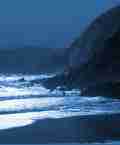

Greencastle (Northburgh),
County Donegal
At first glance the shattered remains of this castle resemble the magnificent Edwardian fortress at Caernarfon. Indeed, it may have been designed by the same person, though Greencastle - called Northburgh by the Normans - was not a royal castle but was built by the "Red" Earl of Ulster, Richard de Burgo, in 1305 to help subdue the O'Neills and O'Donnells and control the entry into Lough Foyle. The castle encompasses a lofty rock platform, whose cliffs afforded good protection on the seaward side. Like Caernarfon, it has an oblong plan with the gatehouse at one end and a large polygonal tower dominating the north-east corner. The three-storey gatehouse, which projects from the side of the rock platform, is the most impressive part of the castle and contained the main apartments.
Once completed, the castle quickly became an important port of supply for the English armies in Scotland. Consequently, in 1316 Edward Bruce lost no time in capturing it after he had invaded Ireland. Two years later it reverted back to the Red Earl and later passed to his grandson, William, who was murdered in 1333 - an event that brought about the end of de Burgo power in Ireland. The murder was an act of revenge for the death of his cousin, Walter Burke, whom William had imprisoned at Northburgh the previous year and left to starve to death. It is said that William's sister, moved by Walter's fate, endeavoured to bring him food but was detected and thrown over the battlements to the rocky shore beneath. A small garrison was maintained here until the 17th century, when it was completely abandoned to the ivy, jackdaws and turf-scented salty air.E of Greencastle village on the Inishowen shore of Lough Foyle. NGR: C 653403.
Click here Irish Castles to buy the newly reformatted book from Amazon.co.uk. The previous edition of Irish Castles is also still available from Amazon.co.uk.
